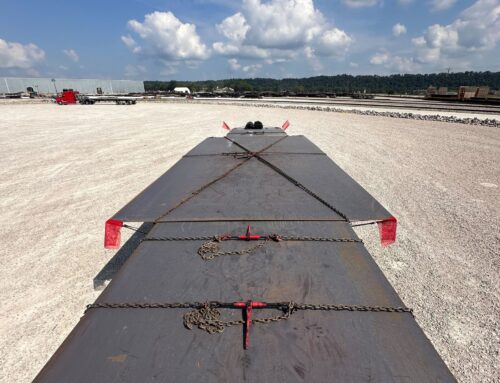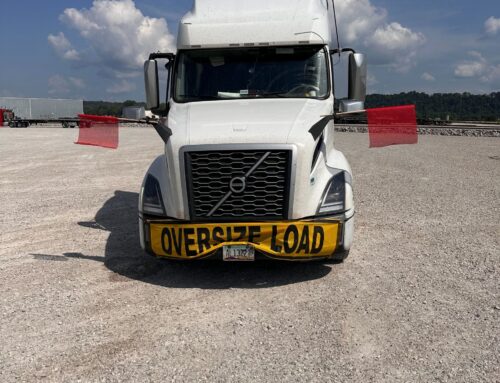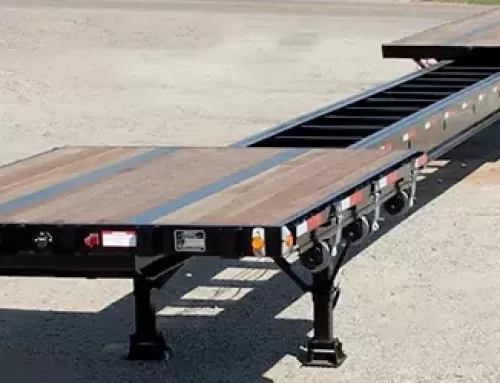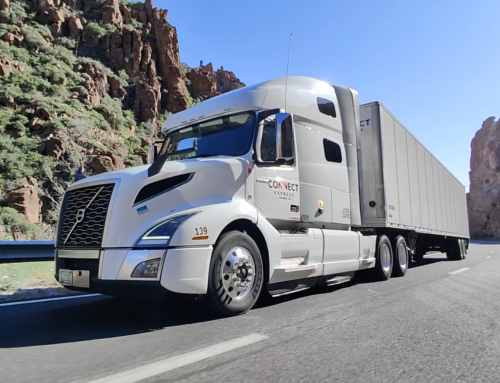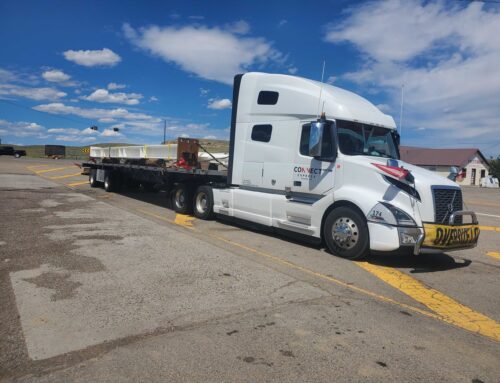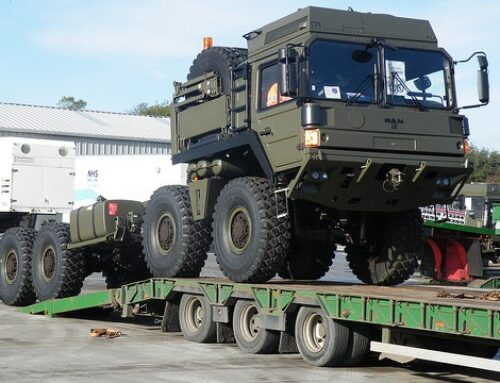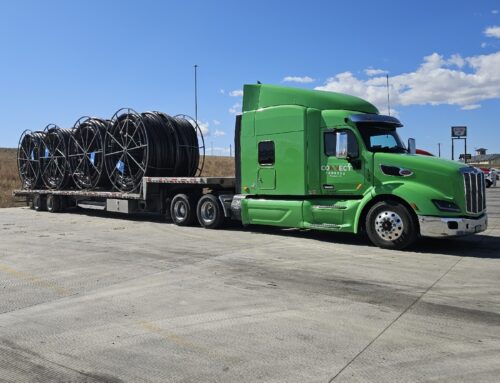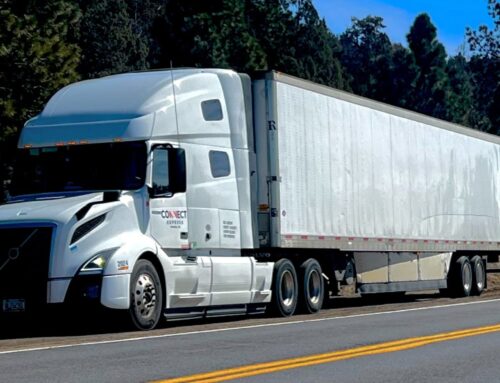
Find the Best Fit for Your Truck
John’s semi-truck had broken down one too many times due to the lack of all-weather tire performance.
In 2024, tire technology advancements offer solutions to such problems, with top manufacturers introducing innovative features, especially for semi-truck trailers.
The importance of selecting the best tires for semi truck cannot be overstated when considering safety, productivity, and profitability.
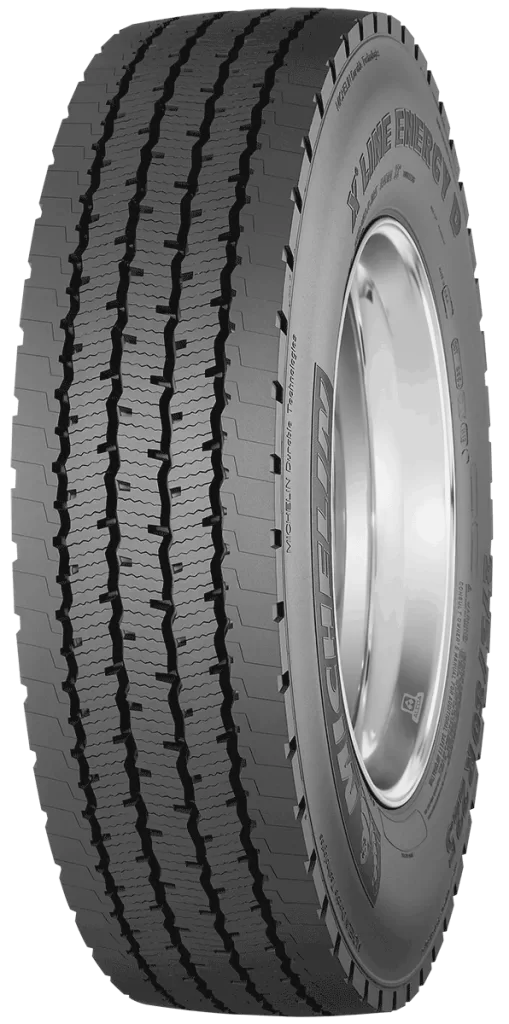
1. Michelin X-Line Energy Z Drive Tire
The Michelin X-Line Energy Z is a standout drive tire renowned for its innovative features, perfect for both truck and trailer. These tires deliver exceptional value, combining advanced technologies to boost mileage, fuel efficiency, and durability.
With an emphasis on extended mileage, this tire offers 20% more mileage than leading competitors, making it ideal for hauling a trailer. The tire’s advanced construction helps lower fuel consumption and reduce irregular wear, ensuring long-lasting performance.
Selecting the Michelin X-Line Energy Z means choosing reliability and enhanced road confidence for both trucks and trailers, making it easier for drivers to steer through various conditions.
1.1. Extended Mileage for Fewer Replacements
Extended mileage for semi-truck tires contributes significantly to improved fleet productivity by minimizing downtime associated with frequent tire replacements.
Increased tire life translates to fewer replacements, providing a substantial boost to overall operational efficiency.
Extended mileage tires are engineered with advanced compounds and construction techniques that promote even tread wear and resilience, ensuring that each tire lasts longer on the road, enhancing efficiency.
Beyond reducing the frequency of replacements, these tires yield economic benefits through lower per-mile costs, enabling fleets to redirect resources towards growth and strategic investments.
1.2. Lower Fuel Consumption for Cost Savings
Choosing tires that lower fuel consumption can lead to significant cost savings for fleets.
- Reduced operational costs
- Enhanced fuel efficiency
- Environmentally friendly operations
- Lower rolling resistance
- Less frequent refueling
Efficient tires contribute directly to improved profitability.
Investment in fuel-efficient tires also supports sustainability goals.
1.3. Enhanced Durability for Consistent Performance
In the demanding world of semi-trucking, enhanced tire durability is a non-negotiable factor that significantly impacts efficiency and reliability.
Durable tires, such as those equipped with advanced construction technologies, ensure that commercial vehicles can endure rigorous conditions, including long hauls and adverse weather. This durability means tires can resist damage from road irregularities, providing a seamless performance over an extended period.
Moreover, these tires are engineered with specialized compounds that offer excellent resistance against wear, cuts, and punctures. By preventing premature degradation, they help fleets avoid unnecessary downtime and the associated costs of frequent emergency repairs.
In essence, the enhanced durability of high-quality drive tires not only promises fewer interruptions but also helps to maximize the return on investment. This proactive approach ensures fleets remain on the road longer, contributing to productivity and the ability to meet deadlines with confidence, ultimately leading to sustained success.
1.4. Reduced Irregular Wear for Smoother Driving
Reducing irregular wear on semi-truck tires is essential to ensure a smooth driving experience and optimal performance.
- Enhanced Traction: Controlled tread stiffness improves grip on various road surfaces.
- Extended Tire Life: Consistent wear patterns lead to longer tire lifespans.
- Smoother Handling: Reduced wear minimizes vibration and noise during transport.
Mitigating irregular wear increases tire longevity and performance.
Commercial drivers benefit from better vehicle control and reduced operating costs.
1.5. Confidence on the Road
Superior tires, especially all-weather variants, are essential to maintaining confidence on the road for semi-truck drivers, ensuring they can steer safely in all conditions.
- Enhanced Durability: Advanced technologies increase tire lifespan, reducing the likelihood of breakdowns.
- Excellent Traction: Innovative tread patterns improve grip, providing stability in all conditions.
- Fuel Efficiency: Reduced rolling resistance lowers fuel consumption, making long-haul journeys more economical.
- Reliable Performance: Consistent performance ensures peace of mind on long trips.
Opting for high-quality tires elevates safety and reliability, particularly for long-haul journeys.
These features collectively ensure that drivers remain confident and secure, mile after mile.
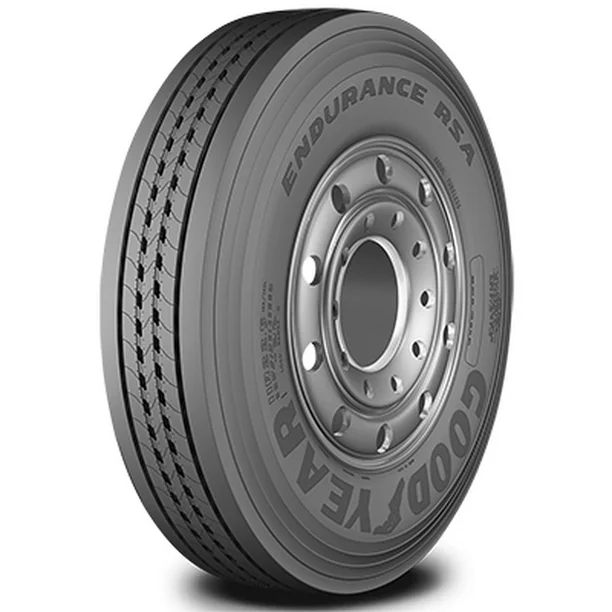
2. Goodyear Endurance RSA Drive Tire
With the Goodyear Endurance RSA drive tire, drivers can experience significant wear resistance, reducing the need for frequent replacements. This exceptional quality makes it a cost-effective option for fleets seeking longevity and durability in their tire choice.
In addition to its durability, the Goodyear Endurance RSA features an innovative tread compound designed for improved fuel efficiency. By reducing rolling resistance, this tire offers better fuel economy, which translates to lower operating costs. The curb impact resistance and superior traction further enhance safety and performance on both urban and highway routes.
2.1. Wear Resistance for Longevity
Selecting tires with superior wear resistance is crucial for ensuring long-lasting performance and reducing frequent replacements.
- Enhanced Tread Compounds: Specially formulated compounds provide robust resistance against wear and tear.
- Curb Impact Protection: Built to withstand sidewall damage from curb impacts.
- Durability Under Load: Engineered to manage heavy loads without rapid deterioration.
- Optimized Tread Design: Ensures even wear, maximizing tire life.
Consistent traction and reduced wear help maintain vehicle stability.
Long-lasting tires contribute to cost efficiency by minimizing downtime and maintenance needs.
2.2. Improved Rolling Resistance for Fuel Efficiency
Improved rolling resistance is a key factor, enhancing the operational efficiency of a semi-truck and ultimately boosting profitability.
By focusing on reduced rolling resistance as a fundamental design feature, modern drive tires enhance fuel efficiency, resulting in significant cost savings. Tires engineered to minimize energy loss during rotation ensure the truck uses less fuel, efficiently converting energy into forward motion.
Consequently, these innovations lead to lower emissions and a smaller carbon footprint. Not only is this beneficial for the environment, but it also aligns with regulatory standards aimed at reducing greenhouse gas emissions from commercial vehicles.
Moreover, semi-trucks equipped with tires optimized for improved rolling resistance can extend their travel range on a single tank of fuel. This efficiency translates to fewer stops for refueling, accelerating delivery schedules and maximizing operational productivity. Embracing low rolling resistance tires is a win-win, ensuring environmental sustainability alongside financial advantages.
2.3. Curb Impact Resistance for Durability
Curb impact resistance significantly improves the overall durability of tires for semi trucks. Tires with superior curb impact resistance can better withstand the physical stresses.
This durability protects against potential damage due to curb impacts. Consequently, the overall longevity of the tire is increased.
Curb impact resistance in commercial drive tires is achieved through advanced material compounds and innovative design elements. This makes them a valuable investment for fleets.
By choosing tires with robust curb impact resistance, operators can minimize downtime and reduce maintenance costs. This leads to more dependable service and enhances fleet reliability, ultimately boosting profitability in the long run.
2.4. Enhanced Traction and Braking for Safety
Safety on the road is paramount, especially when considering the significant demands placed on commercial trucking operations.
Enhanced traction, as seen in tires designed with aggressive tread patterns and innovative siping, allows for superior grip on various surfaces, especially beneficial in all-weather conditions. These designs are particularly effective in adverse weather conditions, reducing the risk of accidents and ensuring consistent handling over long-haul journeys.
Furthermore, braking performance is a critical aspect of tire safety. Tires engineered with specialized compounds and advanced block geometry can provide the friction necessary for shorter stopping distances, greatly enhancing a truck’s braking efficiency and overall control.
By investing in tires with exceptional traction and braking capabilities, fleet operators can ensure their trucks navigate challenging road conditions with ease. This contributes to a safer driving environment, reduces the likelihood of accidents, and ultimately protects both the driver and the cargo, reinforcing the reliability and reputation of the entire fleet.
2.5. Versatility for Various Applications
Versatility in drive tires is crucial for achieving optimal performance across diverse conditions and applications.
From long-haul routes to regional deliveries, each application demands specific tire characteristics. These characteristics can greatly impact the tire’s performance and longevity.
The best drive tires are designed to deliver consistent performance whether on highways, urban roads, or off-road terrains. They adapt effectively to changing surfaces and loads.
When selecting tires, it’s vital to consider their versatility. Tires that can handle varying loads and weather conditions offer immense benefits in terms of operational efficiency and cost savings.
Versatile tires ensure that fleets can operate seamlessly, regardless of route diversity.
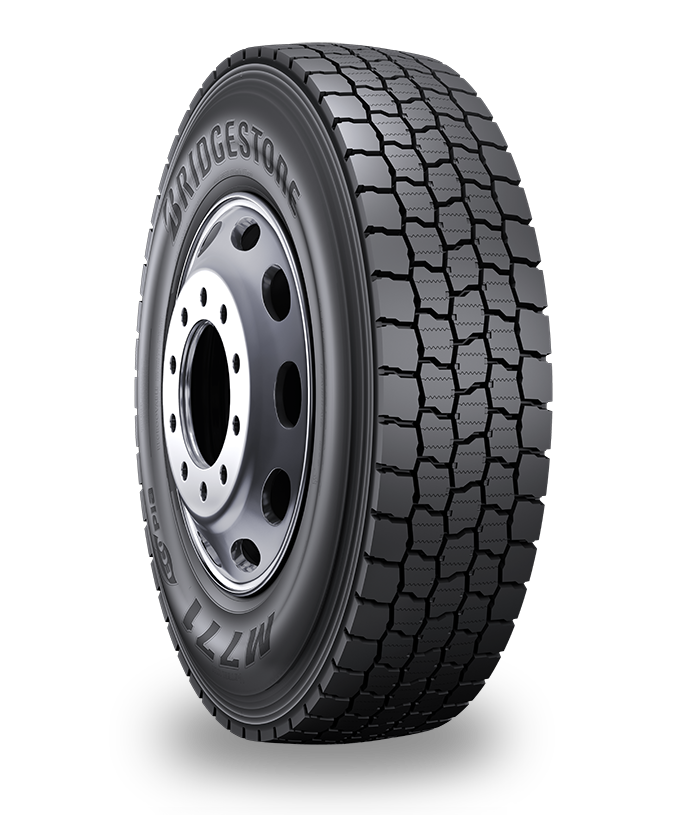
3. Bridgestone M771 Ecopia Drive Tire
The Bridgestone M771 Ecopia is an outstanding choice for the discerning semi-truck operator, thanks to its advanced engineering.
Not only is the Bridgestone M771 Ecopia certified by the CARB (California Air Resources Board) for its environmentally friendly design, but it also ensures reduced rolling resistance for significant fuel savings.
Therefore, operational efficiency combines with environmental responsibility, making this tire a crucial asset for modern fleets.
3.1. Fuel Efficiency for Cost Savings
Fuel-efficient drive tires can drastically cut operating expenses for trucking fleets by minimizing fuel consumption.
- Michelin X-Line Energy Z: Reduces fuel consumption by up to 2.5 liters/100 km.
- Goodyear Endurance RSA: Improved rolling resistance for better fuel economy.
- Bridgestone M771 Ecopia: Ultra-low rolling resistance for significant fuel savings.
- Continental HDR+: Reduces rolling resistance, enhancing fuel efficiency.
- Firestone FD663: Unique tread design to lower rolling resistance, saving fuel.
Choosing tires with advanced technology for fuel efficiency translates to substantial cost savings over time.
Optimal tire selection impacts a fleet’s bottom line positively by reducing fuel expenses.
Thoroughly evaluate fuel-efficient tires to maximize both performance and cost-effectiveness in your operations.
3.2. Environmental Benefits for Compliance
Modern drive tires are designed with environmental benefits that aid in regulatory compliance.
- Reduced greenhouse gas emissions
- Lower rolling resistance
- Longer tread life
- Eco-friendly materials
These features help trucking fleets align with environmental regulations.
Choosing eco-friendly tires could significantly reduce a fleet’s carbon footprint.
Compliance with environmental standards is crucial for sustainable fleet operations.
3.3. Durability and Longevity for Endurance
Commercial drive tires must offer high durability to withstand the rigors of long-haul journeys and rough terrains, resulting in enhanced performance and reduced downtime.
Durability enhances the tire’s service life.
High-quality materials and innovative designs in commercial drive tires play a crucial role in enhancing their overall durability, providing long-lasting performance that directly impacts safety and productivity.
A tire’s longevity is vital for maximizing return on investment, as it minimizes the frequency of replacements and associated maintenance costs, ultimately contributing to a more efficient and profitable trucking operation. Investing in “endurance” tires ensures that fleets remain reliable and competitive in demanding conditions.
3.4. Wet Traction for Improved Safety
Enhanced wet traction is crucial for maintaining safety on slick and rainy roads.
- Reduces the risk of hydroplaning
- Enhances braking performance
- Provides better grip on wet surfaces
- Improves overall handling and control
Wet traction benefits both driver confidence and vehicle stability.
Proper tread design and advanced rubber compounds increase wet traction capabilities.
3.5. Versatility for Multiple Uses
Versatile tires for semi trucks offer exceptional performance on various road surfaces and conditions.
Flexibility is a key trait these tires possess.
Such tires can easily transition from highway travel to urban delivery routes, making them a valuable asset to any fleet facing diverse driving demands.
This versatility translates directly to better adaptability and broader functionality in multiple environments, ensuring logistical efficiency. Whether cruising on the interstate’s smooth expanses or navigating city streets’ tight turns, versatile commercial tires demonstrate remarkable reliability and effectiveness.
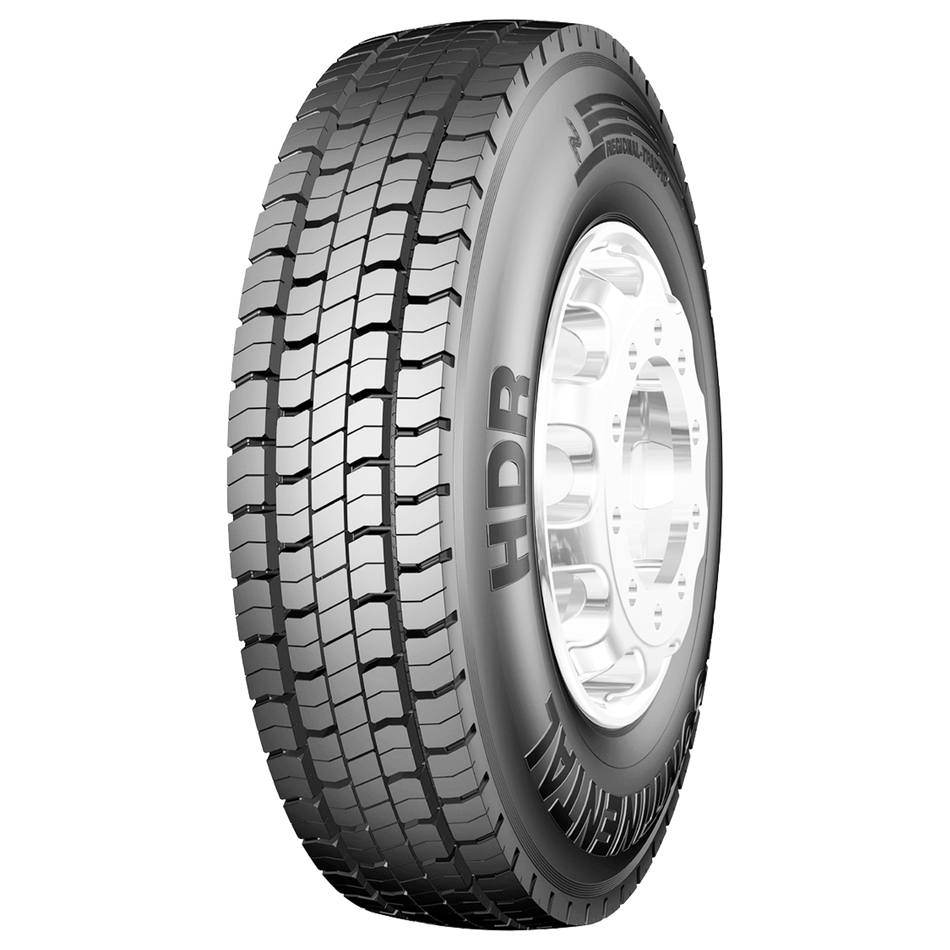
4. Continental HDR+ Drive Tire
The Continental HDR+ drive tire is the perfect choice for your semi-truck due to its numerous benefits and advanced features. Increased longevity, enhanced durability, and excellent traction set this tire apart. Its design includes an improved cap/base tread compound that enhances wear resistance, increasing the tire’s removal miles, thus saving you both time and money.
Choosing the Continental HDR+ means benefiting from off-road capabilities and improved fuel efficiency.
4.1. Increased Longevity for Reduced Replacements
Increased longevity is a key advantage when selecting tires for semi-trucks.
The Continental HDR+ tire is engineered with an advanced cap/base tread compound that elevates wear resistance. Consequently, this feature extends the operational life of the tire, reducing the frequency of replacements.
By incorporating this technology, fleet managers can expect significant savings in maintenance costs. The extended tread life of the HDR+ ensures that trucks spend less time in the shop and more time on the road, boosting overall productivity.
Moreover, fewer replacements mean reduced environmental impact, aligning with sustainability goals. This approach not only conserves resources but also fosters a greener footprint for the trucking industry.
Choosing longer-lasting tires underscores a commitment to efficiency and sustainability.
4.2. Enhanced Durability for Challenging Conditions
Enhanced durability is critical when selecting tires for demanding conditions.
- Wear-resistant compounds
- Robust construction
- Advanced tread designs
- Strong sidewalls
These features ensure the tire withstands harsh environments and extreme usage.
Durable tires reduce the frequency of replacements, saving time and money.
Investing in durable tires enhances safety and reliability on the road.
4.3. Exceptional Traction for Improved Safety
Exceptional traction significantly enhances safety, providing truck drivers with better control and stability on diverse road surfaces.
Improved traction, in particular, contributes to a remarkable reduction in stopping distances, ensuring that trucks can come to a halt more quickly, even during adverse weather conditions. This feature is crucial for avoiding collisions and maintaining safe driving practices, especially on wet or icy roads.
Furthermore, better traction leads to a smoother driving experience over different terrains. As traction increases, the likelihood of tires slipping or losing grip on the road diminishes, providing greater confidence and control while driving.
For instance, advanced siping and tread block designs integrated into these tires maximize grip and resistance. These engineered features work together to optimize performance and safety, translating into better handling and decreased risks of accidents. Consequently, investing in tires that prioritize exceptional traction is a proactive step toward safer, more efficient transportation.
4.4. Off-Road Capabilities for Tough Terrains
Navigating tough terrains poses unique challenges.
Having tires designed for off-road capabilities can make all the difference. Off-road conditions can range from muddy and rocky landscapes to uneven gravel routes, each of which demands specialized tire features to ensure stable travel. Consequently, experts have incorporated design elements into commercial tires that cater specifically to off-road adventures.
Key among these features are deeper tread patterns.
These treads not only provide additional traction but also help in self-cleaning by ejecting debris that could otherwise hinder performance. The tread compound is often more robust to resist cuts, tears, and chips, ensuring longevity even in harsh environments.
Many top brands have emphasized off-road capabilities in their 2024 tire models. By choosing such tires, fleet operators can minimize downtime due to tire failures, ultimately maintaining productivity and profitability. This consideration is vital for operators who frequently face challenging routes, as the right tires can significantly enhance performance and safety.
Fuel Efficiency for Lower Operating Costs
Fuel efficiency directly affects costs, making it imperative to select tires that enhance fuel economy and lower expenses.
Effective tread designs, such as those incorporated in low rolling resistance tires, reduce the energy required to keep the truck moving, which directly contributes to fuel savings. These tires minimize friction between the tire and the road, allowing the vehicle to cover more miles per gallon of fuel, thereby cutting expenditure significantly.
Additionally, reduced rolling resistance means less heat builds up in the tires when driving. By maintaining lower temperatures, these tires not only use fuel more efficiently but also last longer, reducing the frequency of replacements and the associated costs.
Consequently, investing in fuel-efficient tires is an excellent strategy for commercial fleet operators aiming to lower operating costs. This approach not only ensures savings on fuel but also extends tire lifespan, enhancing overall fleet efficiency and boosting profitability.
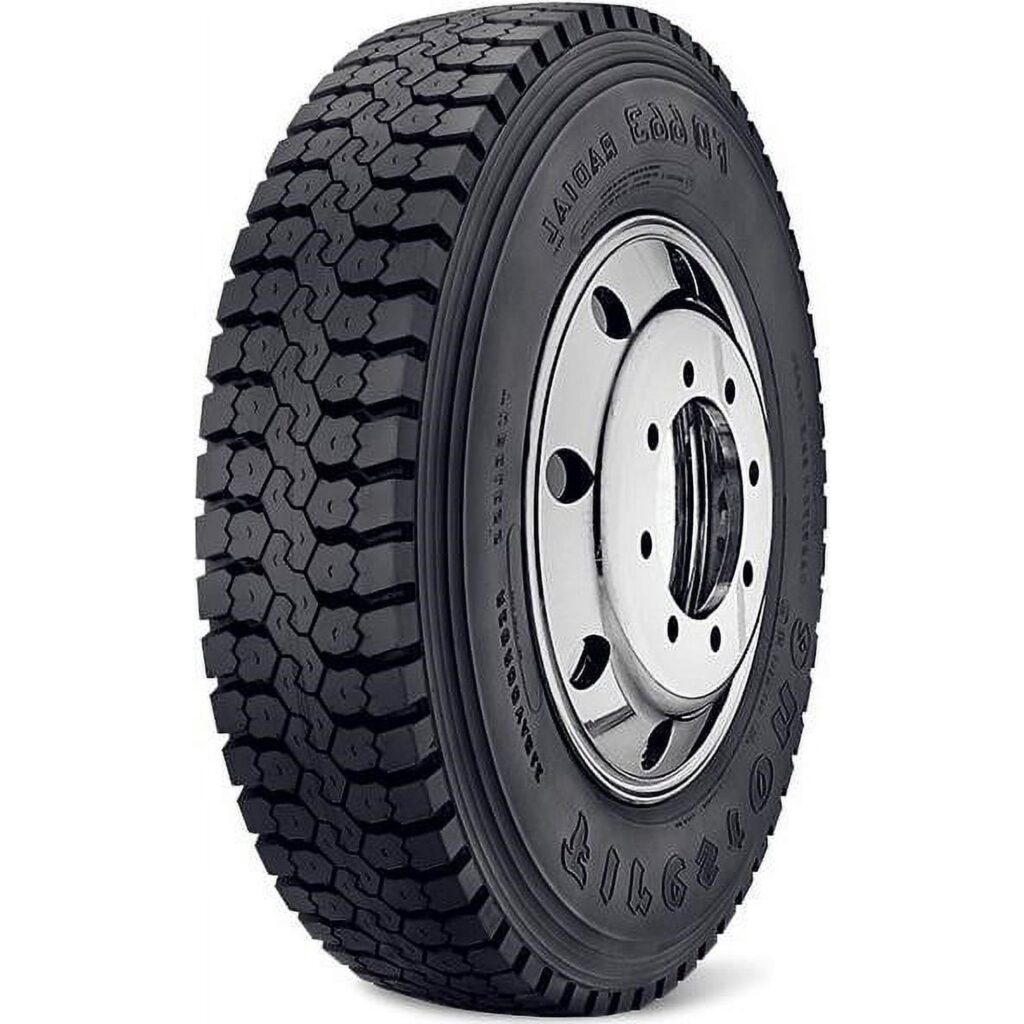
5. Firestone FD663 Drive Tire
Firestone’s FD663 sets the benchmark for traction, offering exceptional performance in challenging conditions.
Engineered with innovative tread patterns, this tire maximizes contact with the road, ensuring stability and control. Its advanced design promotes uniform wear, extending the tire’s lifespan for greater value and efficiency.
5.1. Excellent Traction for Safety
Ensuring excellent traction is crucial for the safety of every commercial vehicle, particularly semi-trucks.
- Improved Stability and Control: Superior traction significantly enhances the vehicle’s stability, ensuring better control in various road conditions.
- Reduced Braking Distance: Tires with great traction shorten braking distance, which is vital for preventing accidents, especially in emergencies.
- Enhanced Performance in Adverse Weather: High-traction tires maintain reliable grip even in wet, snowy, or icy conditions, reducing skidding risks.
- Uniform Wear: Traction-optimized tread patterns distribute wear evenly, leading to longer tire lifespan and consistent performance.
- Retained Road Handling: With excellent traction, drivers experience better road handling, confidence, and comfort during long hauls.
Maximized contact with the road plays a critical role in overall vehicle stability.
Consistent traction prevents slippage and ensures that the vehicle maintains its intended path.
Investment in high-traction tires translates into enhanced safety, performance, and confidence on the road.
5.2. Long-Lasting Durability for Extended Use
Long-lasting tires are essential for maximizing efficiency and reducing replacement costs.
- Heavy-Duty Casing: Ensures the tire withstands heavy loads over extended periods.
- Advanced Tread Compound: Resists cuts, chips, and wear, increasing overall lifespan.
- Reinforced Sidewalls: Provide additional durability against road hazards.
- Stone Ejectors: Prevent debris accumulation, protecting the tire from internal damage.
- Multiple Retread Capabilities: Extend the tire’s useful life through retreading.
These features collectively contribute to the tire’s longevity.
Choosing durable tires is a wise investment for any commercial trucking fleet.
5.3. Smooth Ride for Comfort
A smooth ride is vital for drivers who spend countless hours on the road.
Ensuring comfort during long drives can significantly impact drivers’ overall job satisfaction and productivity.
Modern tire technology focuses not only on performance and durability but also on enhancing ride comfort.
From improved tread designs to advanced materials, today’s best tires can reduce vibrations and road noise, making the journey more enjoyable.
Investing in high-quality tires pays off with a smoother and more comfortable ride.
5.4. Fuel Efficiency for Cost Savings
Maximizing fuel efficiency can greatly enhance a fleet’s economic performance and sustainability.
In 2024, many tire manufacturers focused on developing technologies that reduce rolling resistance, helping fleet operators cut fuel expenses.
Choosing tires designed for optimal fuel efficiency can significantly lower operating costs by improving mileage per gallon.
For example, incorporating advanced compound materials and tread designs in today’s top semi-truck tires enhances energy transfer, leading to better fuel consumption rates.
Overall, investing in fuel-efficient tires not only benefits the environment but also boosts a fleet’s profitability.
5.5. Versatile Performance for Various Conditions
Versatility in tire performance is crucial, ensuring that commercial vehicles can adapt seamlessly to varying road conditions.
This flexibility is vital for truck operators who encounter diverse environments, ranging from highways to rugged terrains. Tires designed with versatile performance in mind offer steadfast reliability, allowing drivers to maintain control irrespective of weather conditions or road surfaces.
Specifically, features like advanced tread patterns and resilient rubber compounds enable these tires to excel. They handle everything from smooth asphalt to gravel and dirt roads, ensuring consistent performance across different transport routes.
In summary, investing in tires known for their versatile performance ensures that a fleet remains operational and efficient, no matter where the journey leads. This adaptability translates to fewer disruptions and a dependable driving experience, safeguarding both cargo and confidence in challenging scenarios.
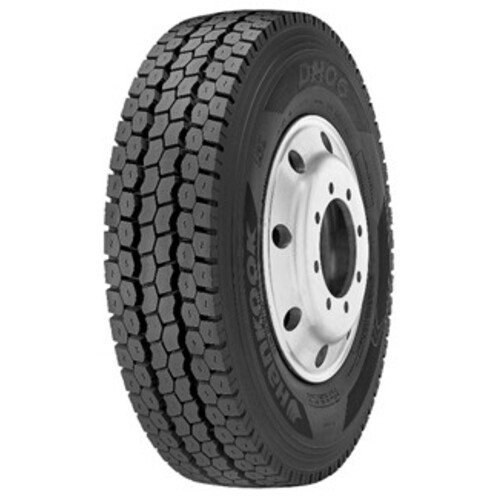
6. Hankook DH06 Drive Tire
The Hankook DH06 drive tire excels in providing exceptional traction, a feature aided by zigzag grooves and an open shoulder design. This tire also focuses on preventing irregular wear, extending its lifespan while maintaining a consistent tread pattern, making it an ideal choice for semi-trucks operating in diverse weather conditions.
6.1. Superior Traction for All Conditions
Superior traction in all conditions ensures safety and reliability for long-haul journeys, even on challenging terrains.
Commercial drivers can better navigate wet, snowy, or uneven roads universally.
This kind of exceptional traction helps in minimizing risks, such as skidding or hydroplaning, leading to a smoother, safer ride for both vehicle and driver.
With advanced tread designs and high-quality rubber compounds being standard features, these tires consistently perform at their peak regardless of external conditions. Whether in rain-soaked highways or snow-covered routes, their adaptability shines, offering fleets the confidence needed to meet delivery schedules without compromising safety.
6.2. Prevention of Irregular Wear for Consistency
Preventing irregular wear is paramount for truck efficiency.
Irregular wear not only shortens the life span of tires but also impacts performance. Poor wear patterns can lead to vibrations, noise, and even pose safety risks. Therefore, investing in tires designed with features that mitigate irregular wear can yield significant long-term benefits.
A balanced tread pattern ensures longevity.
Advanced technology now allows for tires to boast self-cleaning treads and optimized block sizes, which help maintain consistent contact with the road surface. This reduces undue stress on particular areas of the tire, promoting even wear throughout its life cycle.
By ensuring proper alignment and diligently maintaining recommended tire pressure levels, commercial drivers can mitigate the occurrence of irregular wear. Regular inspections for alignment and timely adjustments can further prolong the tire’s effective service period, ensuring a smooth and dependable driving experience.
6.3. All-Season Versatility for Year-Round Use
All-season versatility is a crucial aspect that distinguishes top-tier tires for semi trucks, ensuring they perform exceptionally well in diversified climates.
Such tires offer stable and reliable performance across various weather conditions.
Whether it be scorching summer heat, torrential downpours in autumn, or icy winter roads, having all-season versatility means your truck remains safe, efficient, and never compromised, no matter the elements they’re up against.
This comprehensive drive performance is especially vital for fleets that traverse across regions with variable weather conditions, or those subjected to unexpected climatic changes. As it stands, choosing all-season versatile tires equates to “insurance” in maintaining operational continuity, avoiding unnecessary delays, and keeping safety as a core focus.
6.4. Self-Cleaning Tread for Consistent Performance
Self-cleaning treads are engineered to expel debris, maintaining optimal traction and performance.
- Enhanced Safety: Removal of debris ensures superior road grip.
- Reduced Maintenance: Minimizes the need for frequent cleaning, saving time.
- Extended Life: Protects against damage by preventing stone drilling.
- Improved Fuel Efficiency: Consistent tread pattern reduces rolling resistance.
This technology ensures that tire performance remains reliable across all terrains.
Incorporating self-cleaning tread patterns enhances a semi truck’s readiness for diverse road conditions.
6.5. Longer Mileage for Better Efficiency
Achieving longer mileage for tires significantly impacts efficiency, reducing downtime, a crucial concern in the trucking industry, particularly for long-haul operations that demand maximum productivity.
Extended mileage translates directly to cost savings by minimizing tire replacements.
Additionally, tires designed for longer mileage offer better durability and resistance, essential for consistent performance.
This not only reduces maintenance expenses but also enhances operational reliability, ensuring deliveries are timely.
By investing in tires engineered for high mileage, fleets can optimize fuel consumption, providing a notable return on investment and contributing substantially to sustainability goals.
Moreover, the integration of advanced technologies in these tires ensures they meet and exceed industry standards. Fleet managers must prioritize longer mileage to enhance both efficiency and profitability.
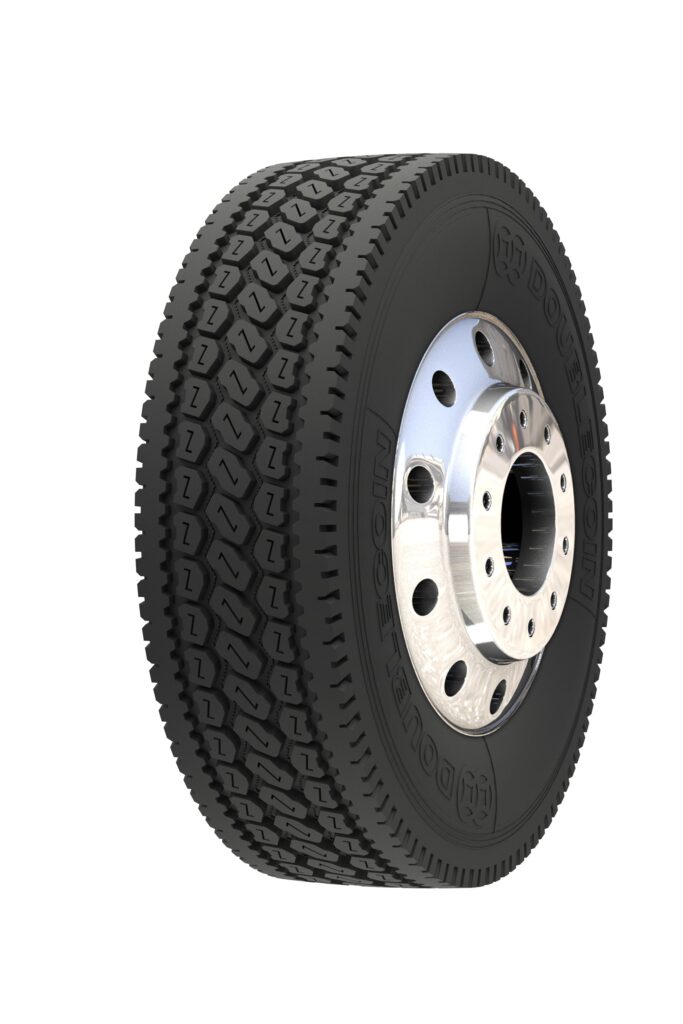
7. Double Coin RLB400 Drive Tire
The Double Coin RLB400 is designed with an extra deep tread and solid shoulder ribs, providing maximum traction on the road. This means you can confidently drive in various weather conditions and terrains, ensuring safety and control.
7.1. Superior Traction for Safety
Superior traction is essential for semi-truck drivers, ensuring stability, a critical element of any commercial vehicle’s optimal performance, especially on challenging terrains.
Good traction minimizes risks in adverse weather conditions.
Hankook DH06 stands out due to its zigzag grooves and open shoulder design.
This ingenious design offers superior traction on wet and snowy roads alike.
Similarly, the Continental HDR+ provides exceptional grip with its 18/32″ extra-deep tread pattern, enhancing driver safety during acceleration and braking.
Traction advantages like these reduce incidents of skidding and loss of control, making every journey safer. Enhanced traction features are indispensable for efficient and safe commercial trucking.
7.2. Longevity for Cost Savings
Choosing tires with longer tread life can yield substantial cost savings for fleet operators.
- Reduced frequency of tire replacements
- Lower maintenance costs
- Increased uptime and productivity
- Enhanced resell value
- Prolonged intervals between services
These benefits translate to greater overall economic efficiency.
Investing in high-durability tires ensures consistent performance and reliability.
7.3. Stability and Durability for Reliable Use
Stability and durability are critical factors, ensuring efficiency, safety, and peace of mind for commercial truck drivers. Robust construction and innovative design elements contribute to tires that withstand heavy loads and extensive wear.
A durable tire reduces breakdowns and maintenance.
Manufacturers like Bridgestone and Michelin emphasize longevity and reliability.
Their advanced tread designs enhance stability, ensuring even wear patterns and optimized grip.
Choosing durable tires for your fleet means fewer replacements, lower costs, and minimized downtime, encapsulating road performance and investment protection.
Thus, the top tires of 2024 offer an unparalleled blend of stability and durability, essential for reliable commercial trucking.
7.4. Retreadability for Extended Life
Investing in retreadable tires provides significant advantages for commercial trucking operations. These benefits include extended tire life spans and cost savings.
Retreadable tires allow multiple reuses of the original casing.
This process maximizes the tire’s value by enhancing its longevity, minimizing waste, and reducing the overall environmental impact. Retreadable tires, backed by advanced technologies, maintain robust performance and reliability after each retread cycle.
Overall, retreadability is a strategic component for long-term efficiency and sustainability in fleet management. It ensures essential cost savings, reduces tire waste, and supports eco-friendly practices while providing dependable performance over multiple cycles of use. This principle aligns with the industry’s commitment to “reduce, reuse, and recycle,” further emphasizing the importance of an efficient and sustainable trucking operation.
7.5. Competitive Pricing for Affordability
For fleet managers, affordability is crucial when selecting tires for semi-truck operations. How can competitive pricing make a difference?
Since 2016, tire manufacturers have increasingly focused on balancing performance with cost. They produce affordable tires without sacrificing essential features needed for long-haul journeys.
Today, it’s no longer necessary to compromise a fleet’s efficiency to save money. Many tire models offer competitive pricing that meets the demands of the industry’s rigorous standards.
Manufacturers have paid close attention to reducing production costs, allowing them to offer budget-friendly tires without compromising quality. This focus ensures that even affordable tires can provide durability, fuel efficiency, and safety.
Competitive pricing helps fleets maintain profitability by reducing overall operational costs. Quality and affordability can indeed go hand in hand.

8. Roadmaster RM257 Drive Tire
The Roadmaster RM257 drive tire is an excellent choice for your semi-truck due to its impressive features, benefits, and lower cost. Designed with curb bars that offer sidewall protection, this tire ensures durability and extended longevity.
Its all-season capability guarantees reliable performance throughout the year, while its aggressive tread design promotes even wear distribution, enhancing overall lifespan and saving costs in the long run.
8.1. Sidewall Protection for Longevity
The importance of robust sidewall protection in commercial tires cannot be overstated, as it directly influences tire durability and minimizes downtime.
This feature, as seen in Roadmaster RM257 and other high-quality tires, safeguards against common hazards like curbing and road debris, which can otherwise cause tire damage. By reinforcing the tire’s integrity, sidewall protection extends the tire’s lifespan even in demanding environments.
Moreover, sidewall protection aids in maintaining consistent performance over accelerated wear. It fortifies the structure, allowing the tires to endure heavy usage and adverse conditions without sacrificing dependability or safety. This results in fewer replacements and lower maintenance costs.
Commercial drivers and fleet managers recognize the value of investing in tires with advanced sidewall protection, ensuring that their vehicles remain operational and safe on the road. Prioritizing such features in tire selection translates to increased productivity, reduced operational interruptions, and enhanced fleet profitability.
8.2. Consistent Traction for Safe Driving
Consistent traction is crucial for maintaining control and safety on the road.
- Superior grip on all road surfaces
- Improved handling in adverse weather conditions
- Enhanced stability during acceleration and braking
- Reduced risk of hydroplaning
- Increased confidence and peace of mind
Ensuring reliable traction helps prevent accidents and promotes safe driving habits.
High-quality tires with advanced tread designs can significantly enhance a vehicle’s traction capabilities.
Investing in tires that offer consistent traction is essential for safe and efficient driving.
8.3. Even Wear Distribution for Extended Use
Even wear distribution is critical for maximizing the lifespan of tires for a semi-truck, and this aspect should not be overlooked.
Tires with an advanced tread design help achieve uniform wear.
The consistent spreading of load and driving pressure across the tread area prevents the formation of irregular wear patterns, reducing the need for premature replacements. This leads to cost savings, enhanced performance, and an overall improved driving experience.
Proper tire maintenance practices, such as regular rotation and alignment, are essential to ensure even wear distribution. By adhering to these practices, semi-truck owners can extend the life of their tires, resulting in significant long-term savings. As the saying goes, “Take care of your tires, and they will take care of you.”
8.4. All-Season Capability for Versatile Use
All-season capability in tires is a pinnacle of versatility, ensuring seamless performance across various road conditions.
Since 2016, leading manufacturers, like Michelin and Goodyear, have extensively researched and developed advanced all-season technologies.
Today, it’s not uncommon to find tires that include specialized rubber compounds and unique tread patterns, designed to handle both hot summer asphalt and icy winter roads effectively.
Such technologies in the tire tread and rubber compounds allow for reliable grip in dry, wet, and even snowy conditions, eliminating the need for seasonal tire changes and offering maximum convenience.
In conclusion, choosing all-season tires for a semi-truck is a wise investment, furnishing drivers with peace of mind and optimal performance year-round.
8.5. Cost-Effectiveness for Budget-Conscious Choices
When managing a fleet, maintaining a budget while ensuring quality tires is paramount, and this balance is achievable with some strategic choices.
Budget-conscious buyers should always consider value alongside price.
Certain tire models offer a remarkable balance of affordability and performance. These choices not only meet but often exceed expectations, providing excellent grip, durability, and fuel efficiency at a fraction of the cost.
Exploring cost-effective options allows fleet managers to get the most out of their tire investment without compromising safety or performance. In this context, comparing moldable characteristic features like “traction” and “durability” across different ranges can significantly aid in decision-making.
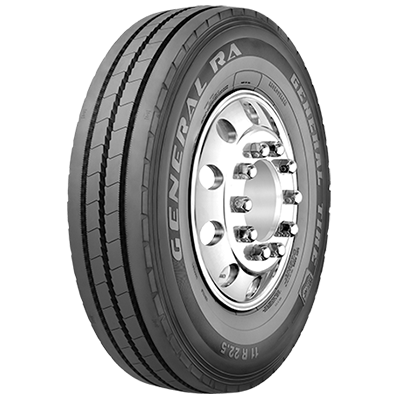
9. General RA Drive Tire
The General RA drive tire exemplifies a harmonious blend of durability and performance. Its aggressive tread pattern ensures exceptional traction under a multitude of conditions, fortifying safety and control.
Additionally, its fuel-efficient design reduces operational costs, while noise reduction features contribute to a more comfortable driving experience.
9.1. Enhanced Traction for Reliable Grip
Why should truck drivers and fleet managers focus on traction when selecting tires for semi trucks?
Since 2016, transportation industry analysts have increasingly emphasized that superior traction is integral to ensuring a secure and efficient journey. Enhanced traction helps semi-trucks maintain a reliable grip on the road, reducing the risk of accidents.
Moreover, the added grip substantially improves braking performance, a critical factor on slippery and unpredictable surfaces. This enhanced control provides drivers with peace of mind, knowing they have a dependable tire beneath their rig.
Revolutionizing the definition of traction, several of the top 2024 tire models include features such as 3D sipes, aggressive tread patterns, and specialized compounds to deliver unparalleled road adherence. Among these, options like the Michelin X-Line Energy Z and Firestone FD663 stand out.
Choosing tires with enhanced traction ensures a safer, more efficient driving experience, aligning with optimal fleet performance.
9.2. Durable Construction for Long Life
High-quality tires for semi trucks are renowned for their exceptional construction and design, which translate to longer-lasting, durable products that can endure the toughest conditions.
Premium materials and advanced technologies ensure these tires maintain their integrity over long hauls.
Such durability results in fewer replacements, amplifying productivity while minimizing downtime and costs. Drive tires specifically engineered for resilience, like the Continental HDR+, incorporate robust compounds that resist wear, cuts, and chips, further extending their lifespan.
Advanced engineering and features such as reinforced sidewalls and innovative tread designs contribute dramatically to the overall durability of tires for semi trucks. As these tires withstand heavy loads and demanding terrains, fleet managers can rest assured of their investment’s worth, experiencing both reliability and cost-effectiveness on every journey.
9.3. Fuel Efficiency for Lower Costs
Fuel efficiency remains a top priority for operators, knowing that optimized consumption can lead to significant cost savings.
In recent years, tire manufacturers have focused intensively on creating tires with advanced rolling resistance technologies, allowing fleets to run smoother and further on less fuel. This shift towards fuel-efficient designs is a win-win for both economic and environmental reasons, highlighting the importance of continuous innovation in tire engineering.
Moreover, these fuel-efficient tires align with a broader strategy of sustainability. As businesses aim to minimize their carbon footprint, opting for tires that contribute to lower fuel consumption supports these green goals and enhances corporate responsibility in reducing emissions.
By prioritizing fuel-efficient tires, fleet operators can achieve measurable reductions in operating costs, rendering their operations more competitive. This strategic investment not only bolsters the bottom line but also underpins a commitment to environmental stewardship, driving forward the agenda of greener, more economical long-haul transport.
9.4. Reduced Noise for Comfortable Driving
Quiet tires significantly enhance driving comfort by minimizing road noise. This is particularly important during long-haul trips, where constant noise can be a distraction and fatigue-inducing.
By selecting tires designed with noise reduction technology, drivers can enjoy a more serene driving experience.
This technology involves the use of advanced tread patterns and specialized rubber compounds designed to dampen sound waves. Consequently, commercial drivers can focus better on the road.
Investing in reduced-noise tires not only improves the driving experience but also enhances overall safety. By reducing noise levels, these tires contribute to a calmer cabin environment, encouraging driver alertness and reducing fatigue, which are critical for long hours behind the wheel. Therefore, prioritizing “quiet” tires in your selection is a smart move for enhancing both comfort and safety.
9.5. Versatility for Various Applications
Versatile tires are crucial to truck operations, offering enhanced adaptability across different environments and conditions.
For instance, an all-season tire capable of operating smoothly in both urban and rural settings, while maintaining optimal performance, becomes indispensable for fleets engaged in diverse trucking requirements. Their adaptability helps mitigate risks and improve efficiency regardless of the scenario faced. Consequently, fleet managers can better organize deliveries and routes without worrying about the tires’ performance.
Furthermore, these tires excel in a multitude of environmental conditions, from snowy winters to scorching summers. By incorporating adaptive design features, they ensure enhanced safety, traction, and handling, even as environmental challenges evolve throughout the year.
In conclusion, choosing versatile tires tailored for varying applications significantly bolsters a fleet’s overall performance, ensuring efficiency and reliability no matter the circumstances. Such versatility not only enhances safety and productivity but also fosters greater profitability within commercial trucking enterprises.

